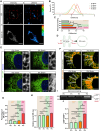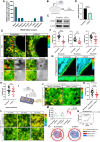External strain on the plasma membrane is relayed to the endoplasmic reticulum by membrane contact sites and alters cellular energetics
- PMID: 40561024
- PMCID: PMC12190009
- DOI: 10.1126/sciadv.ads6132
External strain on the plasma membrane is relayed to the endoplasmic reticulum by membrane contact sites and alters cellular energetics
Abstract
Mechanotransduction is essential for living cells to adapt to their extracellular environment. However, it is unclear how the biophysical adaptation of intracellular organelles responds to mechanical stress or how these adaptive changes affect cellular homeostasis. Here, using the tendon cell as a mechanosensitive cell type within a bioreactor, we show that the tension of the plasma membrane (PM) and the endoplasmic reticulum (ER) adaptively increases in response to repetitive external stimuli. Depletion of stromal interaction molecule 1 (STIM1), the highest expressed PM-ER tether protein, interfered with mechanotransduction from the PM to the ER, and affected the ER tension. We found that an optimized mechanical strain increased ER tension in a homeostatic manner, but excessive strain resulted in ER expansion, as well as activating ER stress. Last, we showed that changes in ER tension were linked with ER-mitochondria interactions and associated with cellular energetics and function. Together, these findings identify a PM-ER mechanotransduction mechanism that dose-dependently regulates cellular metabolism.
Figures









Similar articles
-
Adenovirus Modulates Toll-Like Receptor 4 Signaling by Reprogramming ORP1L-VAP Protein Contacts for Cholesterol Transport from Endosomes to the Endoplasmic Reticulum.J Virol. 2017 Feb 28;91(6):e01904-16. doi: 10.1128/JVI.01904-16. Print 2017 Mar 15. J Virol. 2017. PMID: 28077646 Free PMC article.
-
Characterization of intracellular membrane structures derived from a massive expansion of endoplasmic reticulum (ER) membrane due to synthetic ER-membrane-resident polyproteins.J Exp Bot. 2024 Jan 1;75(1):45-59. doi: 10.1093/jxb/erad364. J Exp Bot. 2024. PMID: 37715992 Free PMC article.
-
How lived experiences of illness trajectories, burdens of treatment, and social inequalities shape service user and caregiver participation in health and social care: a theory-informed qualitative evidence synthesis.Health Soc Care Deliv Res. 2025 Jun;13(24):1-120. doi: 10.3310/HGTQ8159. Health Soc Care Deliv Res. 2025. PMID: 40548558
-
Home treatment for mental health problems: a systematic review.Health Technol Assess. 2001;5(15):1-139. doi: 10.3310/hta5150. Health Technol Assess. 2001. PMID: 11532236
-
STIM1 and lipid interactions at ER-PM contact sites.Am J Physiol Cell Physiol. 2025 Jan 1;328(1):C107-C114. doi: 10.1152/ajpcell.00634.2024. Epub 2024 Dec 2. Am J Physiol Cell Physiol. 2025. PMID: 39620863 Free PMC article. Review.
References
-
- Mathieu S., Manneville J. B., Intracellular mechanics: Connecting rheology and mechanotransduction. Curr. Opin. Cell Biol. 56, 34–44 (2019). - PubMed
-
- Ma S., Cahalan S., LaMonte G., Grubaugh N. D., Zeng W., Murthy S. E., Paytas E., Gamini R., Lukacs V., Whitwam T., Loud M., Lohia R., Berry L., Khan S. M., Janse C. J., Bandell M., Schmedt C., Wengelnik K., Su A. I., Honore E., Winzeler E. A., Andersen K. G., Patapoutian A., Common PIEZO1 allele in African populations causes RBC dehydration and attenuates plasmodium infection. Cell 173, 443–455.e12 (2018). - PMC - PubMed
MeSH terms
LinkOut - more resources
Full Text Sources

